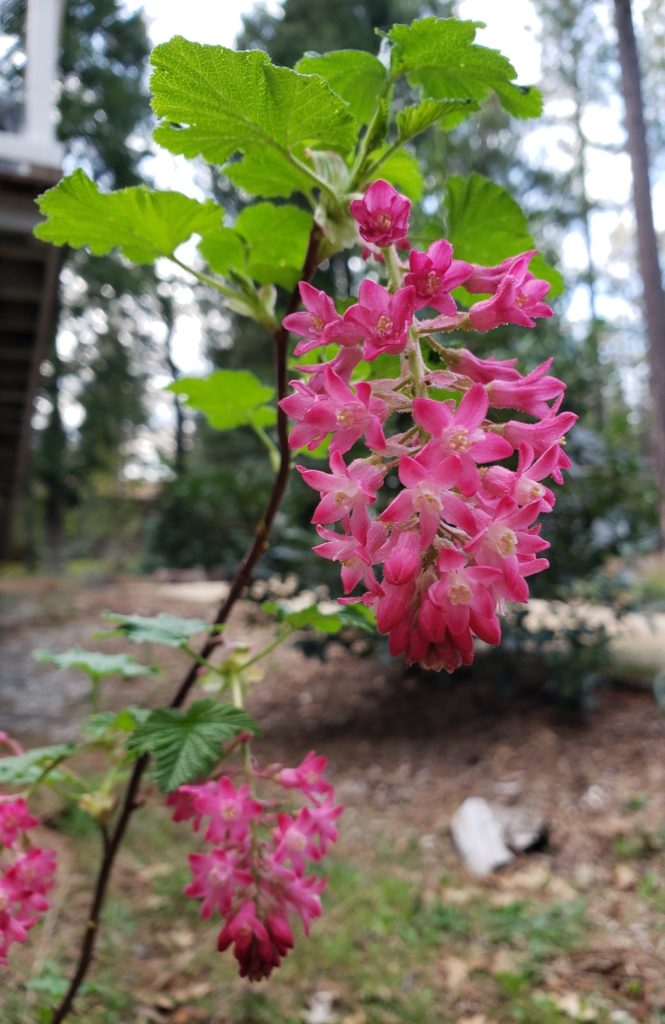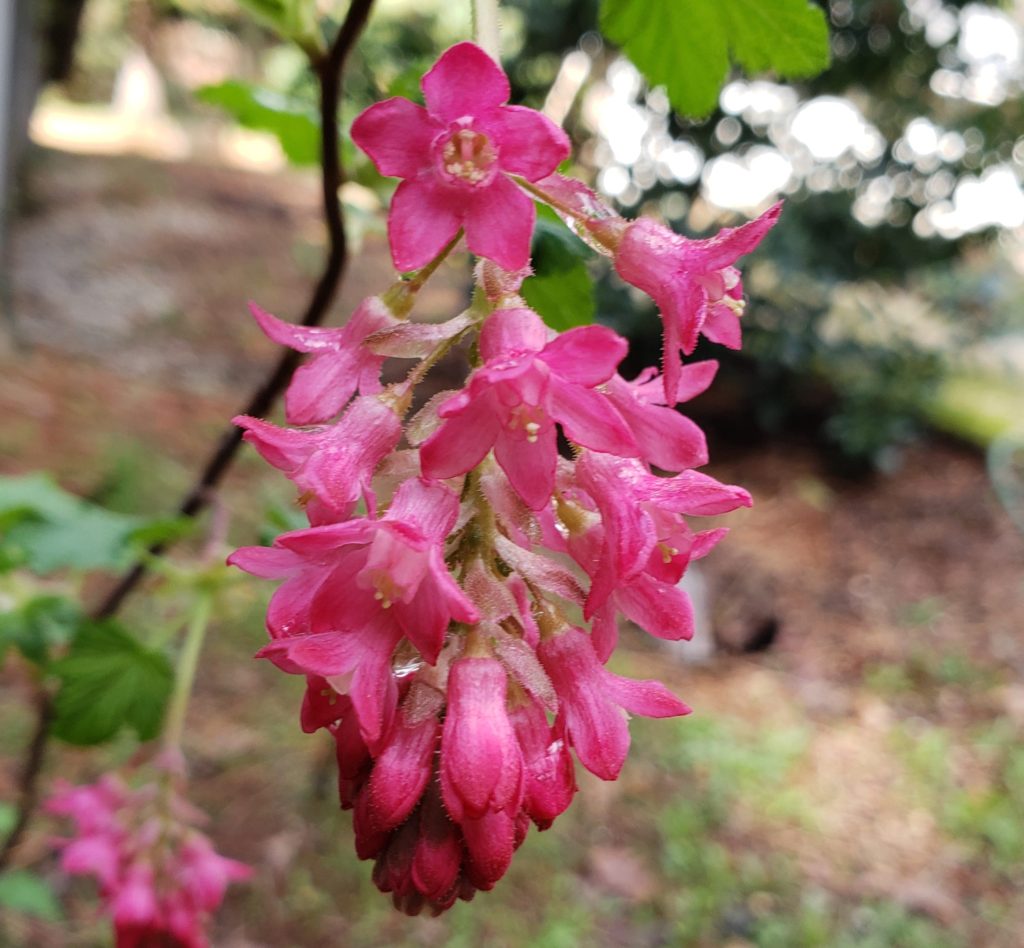If you’re looking for flowering shrubs to add to your landscape that don’t take much water, won’t get eaten by deer, will feed the birds and the pollinators and is an attractive asset to your landscape…here’s one to get.
This stunning shrub blooms early and long
Red flowering currant (Ribes sanguineum) is one of my favorite California native shrubs. What makes this one so pretty is its pendulous, warm pink flowers that start to open from as early as late February and keeps blooming through most of April, depending on your location.
Blue-black berries ripen in late summer, which the birds love. They’re edible for us, too, but not so tasty—best left for the birds.
This shrub has an upright, vase shape, reaching up to 6-10 ft. tall. The branches spread to nearly 7 ft. wide to display their showy flowers.
The deciduous foliage turns to a russet-yellow in fall, another attractive feature for your landscape.
This plant looks good enough for a formal situation, can be clipped as a beautiful flowering hedge, and can tolerate being near a lawn.
It even helps our native bugs, birds, and pollinators!
The foliage is fodder for many of our locally native butterfly and moth caterpillars to provide valuable food for the birds during their nesting season.
In addition to hosting our valuable native insects, currants support hummingbirds and bees. In fact, the Pollinator Program at the Xerces Society for Invertebrate Conservation says that this plant is recognized by pollination ecologists as “attracting large numbers of native bees”, which are actually our most effective pollinators.
It’s not strictly native, but here’s why I like it anyway
This plant is not native to this part of California, so it’s not for the native purist. It’s from cooler, coastal areas and northern mountains of California. But, it does well here and has qualities and named varieties that make it a stand-out shrub.
Plus it does do what locally native plants must do—feed insects that feed birds.
I did a check on Calscape.org, the very useful online interactive source of information on all the native plants of California. I found that red flowering currant feeds up to 85 butterfly and moth caterpillars. I cross-checked 10 species of the butterflies and moths and found them all to live here. And those species eat the foliage of many other native plants that live here, too.
In other words, the R. sanguineum, while not native to our neck of the woods, is able to play the same role of the plants that are, supporting native insects, which is what we need.
So I feel comfortable recommending these get planted here. They’re so pretty, can take a prominent position in your landscape, and there are some extra-nice ones to plant.

Which one to choose?
Red flowering currant, sometimes known as pink flowering currant, has several cultivars that offer a variety of colors to choose from. I think the most outstanding one is ‘King Edward VII’. It has the darkest fuschia-pink flowers of them all, and grows up to 6ft. tall. It makes an outstanding flowering hedge! ‘Claremont’ has extra-long flower clusters in a warm pink. It gets up to 8’ tall and 4ft. wide. And ‘White Icicle’ has white flowers and gets to 8’ tall and 6’ wide.
Our locally native flowering currant, the Sierra Currant (Ribes nevadense) is very similar to R. sanguineum. It has pink flowers, grows to 6’ x 3’ wide, with an upright form and pink flowers. It’s moderately drought tolerant but can tolerate some extra water. It grows well in a variety of soils, so long as drainage is good, which means it shouldn’t get over-watered. During its bloom, it’s such a treat to come across this plant while hiking.
What red flowering currant needs
It likes some shade when they’re planted inland, since they’re native to coastal, cooler areas. They’re perfect for all those partly sunny areas around our forest trees.
They’re low water but will take a little extra water. Calscape recommends watering a maximum of 3 times a month in summer once it’s established.
But remember to always water deeply and infrequently to reach the lower soils and store it there for the plants for the long term. For hot spells, a little more often.
I planted a currant in a new bed with other perennials during the big drought. The soil was shaded by the house for half the day and shaded by the plants as they grew. I watered the bed by slowly flooding it and letting it sink in. For three years through the drought, I watered that bed only three times per summer and everything grew wonderfully. I attribute the success to very deep watering and water-wise plant selection.
Calscape reports that the currants are adaptable to a wide variety of soils, including clay, as long as they have fairly good drainage.
Overall, they’re very easy care plants.
Where to get the plants
Suncrest Nursery, a large wholesale/grower nursery, grows red flowering currant, its varieties, and the Sierra currant. They supply most of the nurseries in our area. A few other nurseries that supply our area also grow some of these plants. This means you can ask to get them from your local nursery when they are available.
So plant some!
Flowering currants are blooming now. I don’t see many of them around town, but they sure deserve to be planted more. As low-water, easy care, deer resistant, very pretty flowering plants that do so much to attract and sustain pollinators and birds, it’s time to put these plants into our landscapes!

